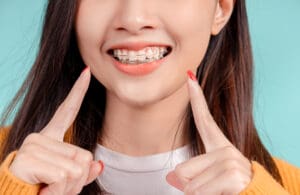Posted on July 13, 2024

Ever wondered why the journey to a perfect smile doesn’t end with braces? That’s where retainers come into play, acting as the unsung heroes in maintaining those straight teeth. These devices play a crucial role in ensuring your teeth remain aligned after braces.
We will provide you with all the essential information about retainers—how long to wear them, the different types available, and how to care for them properly. We aim to give you the information you need to get through life after braces. From daily retainer schedules to orthodontic retainer care, we’ve got you covered.
Ready to learn more about how to keep your smile looking its best? Contact Smilebliss today and let our expert team help you maintain that perfect smile for years to come.
Our personalized approach ensures you get the best care tailored to your needs. Trust us to support you every step of the way to a lifetime of beautiful smiles. Whether you’re finishing up your orthodontic treatment or need ongoing support, we’re here for you.
Get in touch with us today for more details!
Retainers are essential tools in orthodontic care, designed to maintain the alignment of your teeth after braces removal. These ensure that the improvements achieved during orthodontic treatment are preserved, providing stability as your mouth adjusts to its new alignment.
There are two main types to suit different needs and preferences:
Retainers ensure that the hard work done by braces doesn’t go to waste. After braces are removed, teeth can shift back to their original positions without them. This is where retainers come in, holding everything in place while the mouth adjusts.
This phase of treatment is critical. Without a retainer, the risk of needing braces again increases significantly. It underscores the importance of following your orthodontist’s advice closely.
 Understanding the timeline for wearing retainers is crucial for maintaining the results of your orthodontic treatment.
Understanding the timeline for wearing retainers is crucial for maintaining the results of your orthodontic treatment.
Consistent use of your retainer as directed helps secure your investment in your smile, keeping it straight for years to come.
Here’s what to expect:
Understanding the various factors influencing retainer duration is essential for maintaining the results of your orthodontic treatment. The journey doesn’t end after braces, and several key elements determine how long you’ll need to wear a retainer.
Here’s what to consider:
Age and dental maturity play important roles in determining how long you’ll need to wear a retainer. Younger patients may require longer use because of changes in their teeth structure as they grow. Their jaws and teeth are still developing, which can affect the retention phase.
Adults, however, often have a more stable dental structure. This stability can lead to shorter retainer wear times. Yet, everyone’s situation is unique. The key is to follow your orthodontist’s guidance closely.
Specific orthodontic problems like gaps, overbites, or underbites significantly influence retainer duration. Complex cases may require longer periods of retainer use to ensure lasting alignment. Each patient’s needs are unique, and tailored retainer plans can make a significant difference in outcomes. Adhering to your orthodontist’s guidelines is key to preserving the results of your orthodontic treatment.
For instance, closing a large gap might take considerable effort and time during the braces phase; maintaining these results typically requires extended retainer wear.
Patients who had severe overbites or underbites before treatment should prepare for a lengthy retention phase. These conditions tend to be stubborn and could revert without diligent retainer use.
Lastly, how well patients stick to their prescribed retainer schedule has a huge impact on outcomes. Skipping days or not wearing the retainer as advised can lead to teeth shifting back out of place. Consistency is crucial for keeping that perfect smile.
Failure to adhere can extend the duration you need to keep wearing your retainer. It’s simple: the more diligently you follow your schedule, the sooner you might reduce wear time.
 Managing life with retainers involves several important practices to ensure they remain effective and maintain your oral health.
Managing life with retainers involves several important practices to ensure they remain effective and maintain your oral health.
Keeping your retainer clean prevents bad breath and maintains oral health. Regular cleaning routines can also prevent the buildup of harmful bacteria.
Brush your retainer daily using a soft toothbrush and non-abrasive toothpaste, and always rinse under lukewarm water, never hot, as it can warp the retainer.
Storing your retainer properly when it is not in use is equally important. Use its case to prevent damage or loss, and never wrap it in tissue, as many retainers are accidentally discarded this way.
Incorporating your retainer into daily life starts with establishing a routine. Wear it as prescribed by your orthodontist, usually every night after braces are removed, to ensure your teeth stay in place.
Remembering to wear it can be tricky at first, so set reminders on your phone or place notes in visible spots until it becomes a habit. When eating, always remove your retainer to avoid damage and clean both your teeth and the retainer afterwards to keep them in top condition. Consistency in these habits will help ensure your teeth stay perfectly aligned and healthy.
These steps will help you manage life with a retainer effectively and maintain your perfect smile.
Living with retainers can bring up several questions and concerns. Understanding the importance of retainers and how to manage them effectively is key to maintaining your beautiful smile.
Here are some common questions and answers to help guide you:
Can you stop wearing your retainer earlier than advised? Many ask this, hoping for a shorter commitment. The answer is not straightforward. Ligaments in the mouth need time to adjust after braces removal. This process doesn’t end immediately with the removal of braces.
Teeth have a natural tendency to shift back to their original positions, and without a retainer, you risk losing the alignment achieved through orthodontic treatment. Following your orthodontist’s advice on retainer wear is essential for maintaining your perfect smile.
Stopping early can lead to teeth moving back to their original positions. Experts recommend wearing retainers for as long as you want your teeth to stay straight. Long-term use of retainers is often necessary to preserve the alignment, especially at night when teeth can shift the most. Regular check-ins with your orthodontist will help you determine the optimal duration for wearing your retainer.
For some, this might mean years or even a lifetime of nighttime wear. Retainers are not just an accessory; they are a commitment to maintaining your smile. Skipping even a few days can result in noticeable changes.
What if you lose your retainer? First, don’t panic. Contact your orthodontist right away. They can guide you on the next steps, which usually involve getting a replacement quickly to prevent teeth from moving.
In the meantime, try to wear an old retainer if you have one, as it can temporarily help maintain alignment. Prompt action is crucial because even a short period without a retainer can allow teeth to shift. Your orthodontist may also provide advice on temporary solutions until your replacement arrives.
A lost retainer is common, but it’s crucial to act fast. Time is of the essence here; the longer you wait, the more likely your teeth will begin to shift. Replacing a retainer might come with a cost, but consider it an investment in keeping your perfect smile.
We understand how easy it is for retainers to get lost, which is why we have the Retainer Promise Program at Smilebliss. With this program, you get two sets of retainer replacements for up to five years after treatment. These can be paid for in full or in low monthly payments during your treatment.
 Wearing your retainer consistently is vital for preserving the results of your orthodontic treatment.
Wearing your retainer consistently is vital for preserving the results of your orthodontic treatment.
Beyond just keeping your teeth aligned, retainers offer several long-term benefits that contribute to your overall oral health and confidence.
Here are some key advantages:
Oral Health
Beautiful Smile
Wearing a retainer is more than just a post-braces accessory; it’s a commitment to preserving the results achieved through orthodontic treatment. By closely following your orthodontist’s guidance and integrating retainers into your daily routine, you can ensure that your smile remains beautiful and healthy for years to come.
If you have any questions or concerns about wearing retainers or maintaining your post-braces smile, don’t hesitate to schedule a consultation with our experts at Smilebliss.
We’re here to assist you on your journey to a perfect smile with confidence and ease. Keep smiling brightly!
Initially, you’ll likely need to wear your retainer all the time for at least 6-12 months. After that period, your orthodontist might recommend wearing it only at night.
There are mainly three types: Hawley (removable and made of metal wires and plastic), clear plastic retainers (also removable, similar to Invisalign aligners), and permanent retainers (fixed behind your teeth).
Rinse your retainer with cold water after each use. Brush it gently with a soft-bristled toothbrush and non-abrasive toothpaste daily. Avoid hot water, as it can warp the retainer.
In the beginning, wear it full-time except when eating or brushing your teeth. After the initial phase, you’ll transition to wearing it only at night, as per your orthodontist’s advice.
No, stopping the use of your retainer can lead to your teeth gradually shifting back to their original position. Continuous wear, as directed by an orthodontist, is crucial.
Long-term use ensures that your teeth remain aligned and can prevent future dental issues, contributing to overall oral health and maintaining the investment you made in your smile.
Contact your orthodontist immediately. They will advise whether you need a replacement or repair. Delaying can lead to teeth shifting back to their original positions.